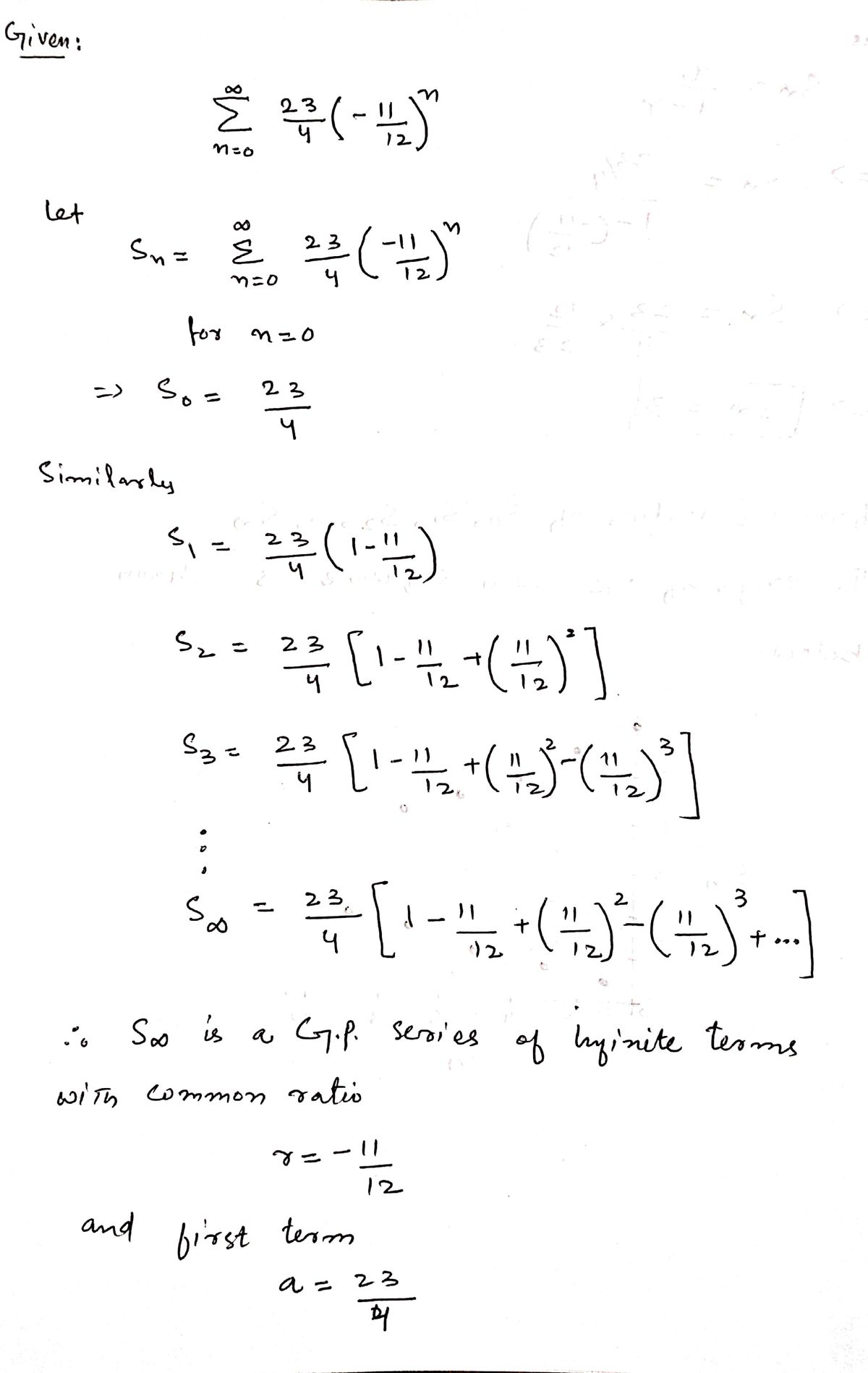Calculus: Early Transcendentals
8th Edition
ISBN:9781285741550
Author:James Stewart
Publisher:James Stewart
Chapter1: Functions And Models
Section: Chapter Questions
Problem 1RCC: (a) What is a function? What are its domain and range? (b) What is the graph of a function? (c) How...
Related questions
Question
a) graph the sequence of partial sums
b) use the graph to estimate the sum of the series.
(please handwrite work not type last time i couldn't make heads or tails of whoever gave the typed solution)
![The given summation is an infinite series represented as follows:
\[
\sum_{n=0}^{\infty} \frac{23}{4} \left( -\frac{11}{12} \right)^n
\]
This expression includes:
1. **Summation** (\(\sum\)): The symbol \(\sum\) indicates that the terms in the series are to be added together from \(n = 0\) to infinity (\(\infty\)).
2. **Fraction \(\frac{23}{4}\)**: The term \(\frac{23}{4}\) is a constant multiplier for each term in the series.
3. **Power of a Fraction** \(\left( -\frac{11}{12} \right)^n\): This is a geometric series where each term involves raising the fraction \(-\frac{11}{12}\) to the power of \(n\).
This is a classic geometric series where the initial term \(a = \frac{23}{4}\) and the common ratio \(r = -\frac{11}{12}\). For convergence, the absolute value of the common ratio must be less than 1. Here, \(|-\frac{11}{12}| = \frac{11}{12}\), which is less than 1, so the series converges.
The sum \(S\) of an infinite geometric series can be calculated using the formula:
\[
S = \frac{a}{1 - r}
\]
where \(a\) is the first term and \(r\) is the common ratio.](/v2/_next/image?url=https%3A%2F%2Fcontent.bartleby.com%2Fqna-images%2Fquestion%2F45235a53-69d6-46fa-83a8-de0bf8bf66d1%2F2b66241c-2987-4d36-879c-ca5364b8a1a0%2F0ad38me_processed.png&w=3840&q=75)
Transcribed Image Text:The given summation is an infinite series represented as follows:
\[
\sum_{n=0}^{\infty} \frac{23}{4} \left( -\frac{11}{12} \right)^n
\]
This expression includes:
1. **Summation** (\(\sum\)): The symbol \(\sum\) indicates that the terms in the series are to be added together from \(n = 0\) to infinity (\(\infty\)).
2. **Fraction \(\frac{23}{4}\)**: The term \(\frac{23}{4}\) is a constant multiplier for each term in the series.
3. **Power of a Fraction** \(\left( -\frac{11}{12} \right)^n\): This is a geometric series where each term involves raising the fraction \(-\frac{11}{12}\) to the power of \(n\).
This is a classic geometric series where the initial term \(a = \frac{23}{4}\) and the common ratio \(r = -\frac{11}{12}\). For convergence, the absolute value of the common ratio must be less than 1. Here, \(|-\frac{11}{12}| = \frac{11}{12}\), which is less than 1, so the series converges.
The sum \(S\) of an infinite geometric series can be calculated using the formula:
\[
S = \frac{a}{1 - r}
\]
where \(a\) is the first term and \(r\) is the common ratio.
Expert Solution
Step 1

Trending now
This is a popular solution!
Step by step
Solved in 3 steps with 3 images

Recommended textbooks for you

Calculus: Early Transcendentals
Calculus
ISBN:
9781285741550
Author:
James Stewart
Publisher:
Cengage Learning

Thomas' Calculus (14th Edition)
Calculus
ISBN:
9780134438986
Author:
Joel R. Hass, Christopher E. Heil, Maurice D. Weir
Publisher:
PEARSON

Calculus: Early Transcendentals (3rd Edition)
Calculus
ISBN:
9780134763644
Author:
William L. Briggs, Lyle Cochran, Bernard Gillett, Eric Schulz
Publisher:
PEARSON

Calculus: Early Transcendentals
Calculus
ISBN:
9781285741550
Author:
James Stewart
Publisher:
Cengage Learning

Thomas' Calculus (14th Edition)
Calculus
ISBN:
9780134438986
Author:
Joel R. Hass, Christopher E. Heil, Maurice D. Weir
Publisher:
PEARSON

Calculus: Early Transcendentals (3rd Edition)
Calculus
ISBN:
9780134763644
Author:
William L. Briggs, Lyle Cochran, Bernard Gillett, Eric Schulz
Publisher:
PEARSON

Calculus: Early Transcendentals
Calculus
ISBN:
9781319050740
Author:
Jon Rogawski, Colin Adams, Robert Franzosa
Publisher:
W. H. Freeman


Calculus: Early Transcendental Functions
Calculus
ISBN:
9781337552516
Author:
Ron Larson, Bruce H. Edwards
Publisher:
Cengage Learning